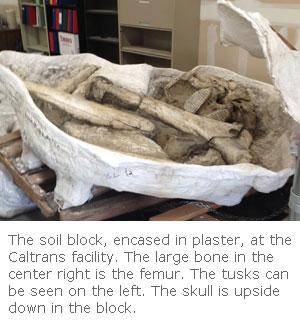School of Social Sciences, Humanities and Arts Dean Mark Aldenderfer
UC Merced to be Future Home of Distant Past
 Ever wonder what lived in the Central Valley 15,000 years ago? Thanks to a forthcoming agreement between the campus and Caltrans, you’ll find out soon enough.
Ever wonder what lived in the Central Valley 15,000 years ago? Thanks to a forthcoming agreement between the campus and Caltrans, you’ll find out soon enough.
Caltrans has been hard at work altering a portion of California State Route 99 in southeastern Merced County, and in that process crews have discovered a series of amazing and impressive findspots of fossil remains that date between 12,000 and 42,000 years ago. Included in the collection are extinct species including dire wolf, ancient llama, horses, bison and camel. Specimens of still-extant species, such as whitetail deer, cougar, jackrabbit, squirrel and a wonderful variety of birds, including sparrows and Canada goose, were also recovered.
 Fossil localities dating to the Late Pleistocene — ca. 11,000-130,000 years ago — are fairly common in the Central Valley, but this discovery is the first instance in which one has been found near Merced. By state and federal law, the excavated remains must be housed in a permanent facility that will provide access to them for scientists and the interested public. Caltrans, wanting to keep the remains local, has asked the campus to develop such a facility, and we are in the initial stages of figuring out how to do this despite our chronic lack of space. We see this as an essential public service consistent with the university’s mission.
Fossil localities dating to the Late Pleistocene — ca. 11,000-130,000 years ago — are fairly common in the Central Valley, but this discovery is the first instance in which one has been found near Merced. By state and federal law, the excavated remains must be housed in a permanent facility that will provide access to them for scientists and the interested public. Caltrans, wanting to keep the remains local, has asked the campus to develop such a facility, and we are in the initial stages of figuring out how to do this despite our chronic lack of space. We see this as an essential public service consistent with the university’s mission.
We want to share these ancient remains with the campus and local community, so we are exploring a way to place one of the most spectacular discoveries in a venue on campus for all to enjoy.
We hope to put on display the remains of an adult Columbian mammoth, known to paleontologists as Mammuthus columbi. Not to be confused with a close relative —the wooly mammoth — the largest of the Columbian mammoths weighed in between 8 and 10 tons, and were more than 13 feet tall at their shoulder. Their diet consisted of very large quantities of grasses, the leaves of shrubs and other vegetation. They used huge tusks to uproot earth in search of food.
 Our specimen is estimated to be between 30 and 49 years of age based on tooth wear and eruption schedules. The remains were removed from the site in a single large block of earth, now stabilized with plaster, that weighs close to 1 ton. Present in the soil block are the skull, tusks, a femur and other bones. Unfortunately, the sex of the mammoth could not be determined. We had hoped to remove the bones from the matrix, but in consultation with experts from the Fossil Discovery Center in Madera, we have been advised that the bones, despite their fossilization, are too fragile for further excavation. In any case, our mammoth will be a worthy addition to our campus and will serve as a reminder of the past that lies beneath our feet.
Our specimen is estimated to be between 30 and 49 years of age based on tooth wear and eruption schedules. The remains were removed from the site in a single large block of earth, now stabilized with plaster, that weighs close to 1 ton. Present in the soil block are the skull, tusks, a femur and other bones. Unfortunately, the sex of the mammoth could not be determined. We had hoped to remove the bones from the matrix, but in consultation with experts from the Fossil Discovery Center in Madera, we have been advised that the bones, despite their fossilization, are too fragile for further excavation. In any case, our mammoth will be a worthy addition to our campus and will serve as a reminder of the past that lies beneath our feet.
Bringing the mammoth to campus will take the efforts of many, and we hope to have it installed on campus by the start of the fall semester. Stay tuned.
